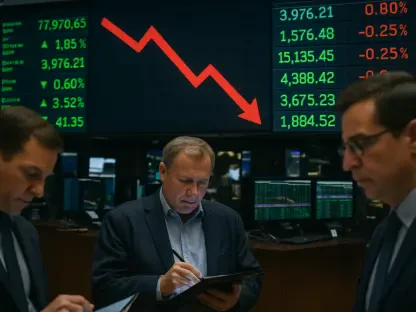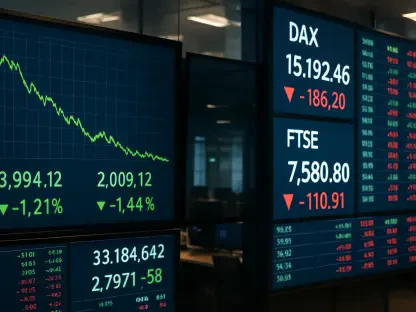In the ever-evolving realm of decentralized finance (DeFi), a new contender is poised to make waves with its innovative approach to digital currency, sparking considerable excitement within the cryptocurrency community. The upcoming launch of USDsui, a stablecoin developed by Sui and slated for release by the end of this year, aims to transcend the limitations of existing stablecoins tethered to specific blockchain networks by prioritizing interoperability and regulatory compliance. This dual focus could address persistent challenges like fragmented ecosystems and legal uncertainties that have long plagued the crypto market. As the DeFi space continues to mature, the potential for USDsui to carve out a unique niche is undeniable, especially in a landscape dominated by heavyweights like USDT and USDC. This stablecoin’s vision of seamless cross-platform transactions and trust-building measures might just redefine what users and investors expect from digital dollars in a competitive arena.
Breaking Down Blockchain Barriers
The cornerstone of USDsui’s appeal lies in its commitment to interoperability, a feature designed to tackle one of the most frustrating issues in blockchain technology. Many stablecoins today operate within isolated networks, forcing users to navigate cumbersome processes or incur high fees when transferring assets across different platforms. USDsui, launching on Bridge’s open issuance platform, promises to dismantle these barriers by enabling fluid transactions across major blockchain ecosystems. This isn’t merely a technical upgrade but a transformative shift that could unify disparate parts of the crypto market. Enhanced liquidity and reduced transaction friction stand to benefit a wide range of users, from casual participants to professional traders, by simplifying how value moves in the digital space. If successful, this approach might encourage a broader rethinking of how stablecoins are structured to interact within the DeFi landscape.
Beyond the immediate user benefits, interoperability through USDsui could have far-reaching implications for the industry at large. By fostering a more connected financial environment, this stablecoin may lower the entry barriers for newcomers who often struggle with the complexities of multi-platform asset management. For seasoned investors, the ability to seamlessly shift resources between DeFi applications and exchanges offers newfound flexibility in portfolio strategies. Moreover, setting a precedent for cross-platform compatibility could pressure other stablecoin developers to adopt similar frameworks to remain relevant. The ripple effect might lead to a more cohesive crypto economy where isolated silos become relics of the past. As USDsui prepares to roll out, its potential to reshape user expectations and drive innovation across blockchain networks is a development worth watching closely in the coming months.
Building Confidence Through Compliance
An equally significant aspect of USDsui’s strategy is its strong emphasis on regulatory compliance, particularly with U.S. financial standards. In an era where global authorities are intensifying scrutiny over digital assets, this focus serves as a deliberate effort to instill trust among users and attract institutional interest. Many cryptocurrencies still operate in ambiguous legal territory, creating hesitation among potential adopters wary of unforeseen risks. USDsui counters this by aligning with established guidelines, positioning itself as a reliable option in a volatile market. This isn’t just about meeting legal requirements but about creating a sense of security for individuals and organizations alike. Such a proactive stance could be the key to bridging the gap between traditional finance and the burgeoning world of DeFi, paving the way for broader acceptance.
The implications of USDsui’s compliance-first approach extend beyond mere user reassurance to potentially unlocking significant market opportunities. For retail users, knowing that a stablecoin adheres to recognized financial protocols offers peace of mind when engaging in transactions or holding digital assets. For institutional players, who often command substantial capital, this regulatory alignment signals a safer entry point into the crypto sphere, potentially driving large-scale investments into the Sui ecosystem. As the industry grapples with calls for greater transparency, USDsui’s forward-thinking design might position it as a frontrunner in attracting diverse stakeholders. This could catalyze a shift where compliance becomes not just a necessity but a competitive edge, encouraging other projects to follow suit and ultimately fostering a more mature and stable digital finance environment over time.
Navigating a Competitive Landscape
Despite its innovative features, USDsui must contend with a highly competitive stablecoin market already dominated by entrenched players like USDT and USDC. Gaining traction in such an environment requires more than just promising technology; it demands tangible evidence of superior benefits, whether through lower costs, faster transactions, or unmatched ease of use. Convincing users to transition to or even trial a new stablecoin will be a formidable task, especially when loyalty to established names runs deep. USDsui’s success will hinge on its ability to demonstrate clear advantages in real-world applications, ensuring that its interoperability and compliance translate into practical value for everyday DeFi participants. The challenge lies in not just meeting but exceeding the expectations set by current market leaders.
Additionally, the evolving regulatory landscape presents an ongoing hurdle for USDsui’s adoption and longevity. While its alignment with current U.S. financial guidelines is a strength, the rapid pace of policy changes globally means that maintaining compliance will be a continuous effort. Regulatory shifts could introduce unforeseen complexities, requiring agility and foresight from Sui to adapt without compromising user experience. Furthermore, market saturation poses a risk, as an influx of new stablecoins could dilute attention and resources. USDsui will need to carve out a distinct identity amidst this noise, leveraging its unique features to stand out. As the launch approaches, the ability to navigate these competitive and regulatory dynamics will be critical in determining whether this stablecoin can truly establish itself as a transformative force in the DeFi arena.
Shaping the Future of Digital Finance
Reflecting on the journey so far, the introduction of USDsui marks a pivotal moment in addressing systemic challenges within the cryptocurrency domain. Its dual emphasis on interoperability and regulatory compliance tackles critical issues like blockchain fragmentation and trust deficits head-on. By facilitating seamless transactions across platforms and aligning with financial standards, USDsui offers a glimpse into a more integrated and secure digital economy. The anticipation surrounding its debut underscores a collective hope for innovation that could elevate industry benchmarks, even as it faces stiff competition and regulatory uncertainties. Looking back, the groundwork laid by this stablecoin highlights a bold vision for what digital currencies could achieve when designed with user needs and systemic stability in mind.
As the crypto community moves forward from USDsui’s launch, attention should turn to actionable steps that build on its foundational ideas. Stakeholders across the DeFi spectrum might consider advocating for wider adoption of interoperable frameworks to further reduce ecosystem silos. Simultaneously, collaboration between developers and regulators could help craft adaptive policies that support innovation while safeguarding users. For investors and users, exploring how USDsui’s model can integrate with existing financial tools offers a practical next step to maximize its benefits. The path ahead involves not just celebrating past milestones but actively shaping a future where stablecoins drive inclusivity and efficiency in digital finance, setting the stage for even greater advancements in the years to come.









